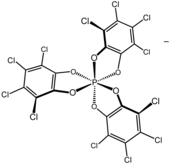| |||
| Names | |||
|---|---|---|---|
| IUPAC name Tetrabutylammonium tris(3,4,5,6-tetrachlorobenzene-1,2-diolato-κO,O)phosphorus(V) | |||
| Other names
Tetrabutylammonium tris(tetrachlorocatecholato)phosphorus(1−) Bu4N PHAT 1-Butanaminium, N,N,N-tributyl-, (OC-6-11-Δ)-trisphosphate(1−) (1:1) | |||
| Identifiers | |||
| CAS Number |
| ||
| 3D model (JSmol) |
| ||
| ChemSpider |
| ||
| ECHA InfoCard | 100.164.647 | ||
| EC Number |
| ||
| PubChem CID |
| ||
| CompTox Dashboard (EPA) |
| ||
InChI
| |||
SMILES
| |||
| Properties | |||
| Chemical formula | |||
| Molar mass | 1011.06 | ||
| Appearance | colourless solid | ||
| Solubility in water | CH2Cl2 | ||
| Except where otherwise noted, data are given for materials in their standard state (at 25 °C , 100 kPa).
| |||
TRISPHAT (full name tris(tetrachlorocatecholato)phosphate(1−)) is an inorganic anion with the formula P(O
2C
6Cl
4)
3 often prepared as the tributylammonium ((C
4H
9)
3NH
) or tetrabutylammonium ((C
4H
9)
4N
salt. The anion features phosphorus(V) bonded to three tetrachlorocatecholate (C
6Cl
4O
2) ligands. This anion can be resolved into the axially chiral enantiomers, which are optically stable (the picture shows the Δ enantiomer).
The TRISPHAT anion has been used as a chiral shift reagent for cations. It improves the resolution of H NMR spectra by forming diastereomeric ion pairs.
Preparation
The anion is prepared by treatment of phosphorus pentachloride with tetrachlorocatechol followed by a tertiary amine gives the anion:
- PCl5 + 3 C6Cl4(OH)2 → H + 5 HCl
- H + Bu3N → Bu3NH
Using a chiral amine, the anion can be readily resolved.
References
- Ratni, Hassen; Jodry, Jonathan J.; Lacour, Jérôme; Kündig, E. Peter (2000). " Salt, an Efficient NMR Chiral Shift Reagent for Neutral Planar Chiral Tricarbonylchromium Complexes". Organometallics. 19 (19): 3997–3999. doi:10.1021/om000437f.
- Favarger, France; Goujon-Ginglinger, Catherine; Monchaud, David; Lacour, Jérôme (2004). "Large-Scale Synthesis and Resolution of TRISPHAT Anion". Journal of Organic Chemistry. 69 (24): 8521–8524. doi:10.1021/jo048641q. PMID 15549835..

